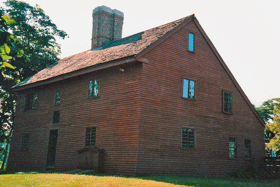Organization
The Salem Witchcraft Website is organized into four major parts. Users may proceed in sequence or move back and forth by means of the navigation menu or the site map.
Part One, "Setting," provides historical information about Salem Village, its church, and its minister at the time of the witchcraft outbreak, Rev. Samuel Parris.
Part Two focuses on chronological and geographic dimensions of the 1692 outbreak. It explores the timing of events as well as their location. When, for example, did the first accusations occur? When did accusations spread beyond Salem? How many communities had accused witches? Were any patterns evident in the way the outbreak progressed? This section has two interrelated subsections,"Chronology of Salem" and "Geography of Salem."
Part Three, "Salem Village Discord," narrows the focus to Salem Village itself and concentrates on how Salem Village's long history of factionalism might be associated with the witchcraft episode. A connection between Salem Village factionalism and the events of 1692 is incisively argued by Paul Boyer and Stephen Nissenbaum in their award-winning study, Salem Possessed: The Social Origins of Witchcraft. Building upon their work, this section investigates the social, political, and economic divisions that shaped Salem Village's actions in 1692. However, this program's analysis of the historical record does not always agree with that of Boyer and Nissenbaum, and users can make their own judgments based upon the evidence available.
Part Four, "Conclusions," summarizes the significant findings of the analysis undertaken in this program. This section also contains "Notes," "Bibliography," and "Credits," pages where further information about Salem and this website can be found. Since this website is aimed at various audiences, I chose not to break the flow of analysis by introducing footnotes. Instead, references for historical information, found primarily in the Settings section, can be found under a particular page's name in the Notes area. Information about images can be found by clicking on the image or by navigating to Credits.
It is hoped that the issues explored in this program will inspire further inquiry and new ideas about Salem witchcraft. Some questions may be further pursued by using the data sets. Others can only be investigated by examining historical sources, such as the books and archival material listed in the bibliography.
A brief word about terminology. For stylistic reasons, various phrases like "Salem trials," "Salem witchcraft outbreak," and "Salem witchcraft" are used to refer to the witchcraft episode of 1692. As will become apparent, the actual "trials" constituted only a portion of chronological span of events. Further, the word "Salem" itself can cause misunderstanding in that it references two related but distinct communities, Salem Town and its precinct, Salem Village. Moreover, the outbreak involved many communities beyond Salem. I have tried to ensure that the context makes clear whether the discussion involves Salem Town, Salem Village, or both. Finally, when encountering the word "witch," the reader should understand that the accused was "alleged" to be a witch. While evidence exists that a few of those accused during 1692 had, in fact, engaged in occult practices and were practicing some form of witchcraft, even they are considered as alleged witches.
To begin exploring the historical background to Salem witchcraft, click Next.
